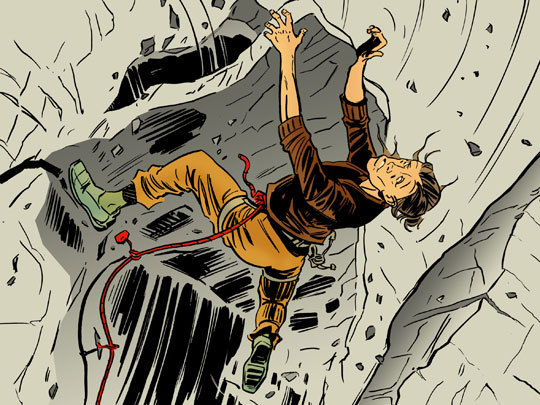
[Illustration] Melchor Thaler
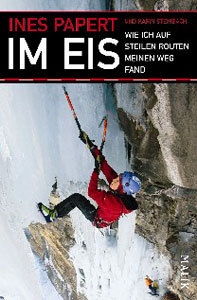
[Photo] de.overview.mail.yahoo.com
Editor’s Note: Ines Papert is one of the world’s most accomplished climbers. She has traveled extensively (read “Dreamfall” in Alpinist 22 to learn about her adventures in Iceland) and won numerous ice-climbing titles, including overall first place at the 2005 Ouray Ice Festival.
Yet, at 34 years old, Papert continues to grow as a climber in an unorthodox way–being a successful climbing mother, or “mum” as she prefers. Now retried from the competition arena, she travels in search of earth’s greatest treasures: alpine summits, new ice lines, free single- and multipitch rock routes. Into the Wild (M12 WI5, 100m)–a four pitch mixed line she bolted ground up this past winter in Icefall Brook (read the March 27, 2008 NewsWire for more information)–is one of Papert’s affirmations that she will continue to test the limits of what is possible on ice and rock.

[Photo] www.stephan-siegrist.ch
In 2005 her climbing ambitions drove her life so unilaterally that placing second in the ice world championship was a crushing blow. Despite a successful trip with the late Harald “Hari” Berger to Norway, where they harvested numerous first ascents, the depth of her dissatisfaction seemed bottomless. For months she drowned her despair by climbing relentlessly.
Then, on July 15th of that year, when–with climbing and life partner, Swiss alpinist Stephan Siegrist–she attempted to find “the way through the Fish” (Via Attraverso il Pesce: 7b+ [5.12c], 37 pitches, 850m) on the south face of the Marmolada, she also unexpectedly found the way to her life.
The following excerpt, which documents this life-changing moment, was translated for Alpinist.com from Papert’s book, Im Eis (In the Ice). Many thanks also to Melchor Thaler, whose illustrations here also are featured in Robi Koller’s book, Stephan Siegrist: Balancing between Mountains and Mondays.
Falling
Right then, I felt the whole flake moving outward and instantly started falling with it. It all happened within a split second, yet I felt like the fall would never end. “Keep your head up, keep your head up…!” I remember telling myself repetitively. As I flew past the anchor and read the distress in Stefan’s eyes, I knew this was serious. I was simultaneously vividly aware of the deadly flake. Because of the relatively low angle of the terrain above the anchor, this huge piece of rock kept bouncing on the slab, exploding into a thousand little pieces. The rest was a blur. I don’t remember impacting the belay ledge with my right foot–which, I am convinced, is how it broke–or my screams of sheer panic, which Stef later told me about.
The much-expected jolt on the rope put an end to my freefall through the Italian landscape. I was now dangling from a single strand of rope, 10 meters below the anchor. The force of my 20-meter fall had ripped all the Friends out of the cracks and water runnels. I wasn’t surprised. It had been hard to find a good placement in the slabby limestone, but I somehow had to protect the anchor, and myself, from exactly what had happened.
My state of shock prevented me from grasping the consequences of my fall. At first, everything seemed all right. We would naturally proceed with our thirty-seven pitch, 5.12c climb. I just needed to untangle my foot from the chaotic mess of rope above my head, climb back to the anchor and get back on route. As I pulled my right foot down and tried stepping on it to climb up, a throbbing pain above my ankle nearly made me pass out. The reality of the situation was settling in. With what seemed like a broken limb, I wondered how I would get back up to the anchor.
I used all the strength in my arms to pull myself up one meter, two meters. Then suddenly, the rope sagged. I fell again. This time, though, I was sure the rope had severed from rockfall damage–if so, I would not stop until I landed on the meadow four pitches below.
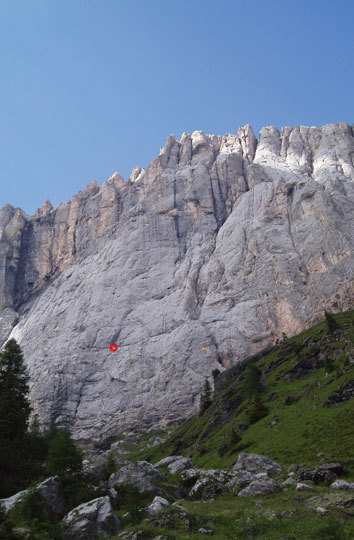
The 2,100′ south face of the Marmolada, Dolomites, Italy. Ines Papert and Stefan Siegrist were four pitches off the ground on Via Attraverso il Pesce (7b+ [5.12c], 37 pitches, 850m) when Papert took a life-altering fall in the vicinity of the red circle.
To my great relief, the rope was intact and came taut again. I had fallen as the tangle of ropes came undone above me as I yanked upward. But the distance to the anchor was now even greater. I tried to breathe deeply and regularly to block out the growing panic. I found comfort and inspiration in thinking about French alpinist Catherine Destivelle’s accident in Antarctica, where she suffered an open fracture of the leg. I recalled how complicated her rescue had been, forcing her to endure days of pain and cold temperatures. In comparison, my case wasn’t quite so bad. I had to be strong. I would not lose consciousness.
Meanwhile, Stef devoted the little gear he had available to build a pulley system that lifted me to the belay. Back to the safety of the ledge, I started to grasp just how fortunate we had been. We had both a lead rope and a tag line to pull the backpacks up or to use in case of retreat. The rockfall had completely shredded the tag line in several spots. And the lead rope was in no better shape: the section that had kept me alive had a slight tear, but the rest of it was completely destroyed. I was lucky to be alive.
And so was Stef. The 10’x10′ flake I pulled off had shattered on impact, a few meters above the anchor, dissolving into a sprinkle of rocks of all sizes and shapes that flew downward like little rockets, destroying everything that stood in its way. Although he has no recollection of it, Stef’s foot must have been hit hard, because he could not bear weight on it.
Our backpack with the mobile phone and first aid kit had fallen in the accident. Our ropes were now useless to help us retreat. Although we were embarrassed to admit it, our only hope was to call for help.
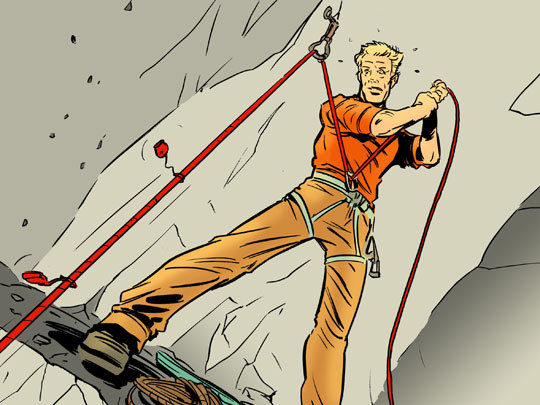
[Illustration] Melchor Thaler

[Illustration] Melchor Thaler
It was 6:30 a.m. when the accident happened, and the little hut at the base of the cliff still lay dormant. No one would step outside until the front steps were bathing in warm rays of sun. Around 8 a.m. we finally saw someone venture into the morning chill. We started yelling “Aiuto! Aiuto!” Our plea was heard, and another painful hour later the sound of a chopper delivered the promise of a rescue… we watched it near the south face. Unexpectedly, it turned around and left. Clouds were building. What if the weather became too bad to fly?
We were now engulfed in a thick cloud, which seemed to isolate us from the rest of the world and let me sink into an ever-deeper state of terror. By now, the throbbing pain was relentless. My whole body was shivering from the cold. I was starting to loose hope. Then, before I could grasp what was happening, a man hanging from a cable broke through the mist, clipped me into his harness and flew me down to the meadow at the base of the wall.
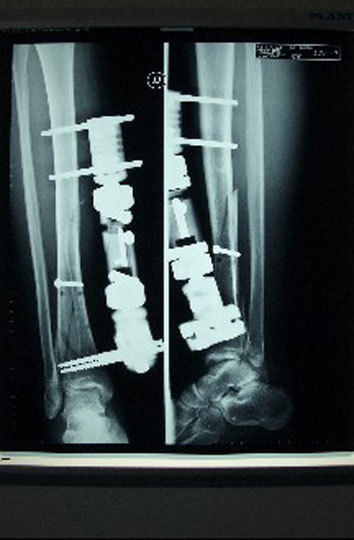
An X-Ray of Papert’s leg after the fall. “My leg seemed to have been reconstructed with no less than two pounds of metal,” she recalled.
The initial care took place right there and then. I will never forget the sweet deliverance provided by the painkillers. Stef and I were flown to the closest hospital in Agordo. Neither of us spoke Italian, and communication therefore proved very difficult. By the looks of it, I had a complicated fracture of the lower leg, which needed immediate surgery. Stef had such intense pain in his foot that he could not walk without crutches. But the doctors could find nothing wrong on his X-Rays. They offered him no treatment. Two months later, he would be diagnosed with an overseen fracture of the lower ankle [read “Lightning Strikes Last” in Alpinist 22 for more about the accident and Siegrist’s recovery. –Ed.]
With no money–our wallets were in our backpack at the base of the wall–we had no means to call home or figure out how to return to Germany. When I came out of surgery that same night, my leg seemed to have been reconstructed with no less than two pounds of metal. The limb was huge and growing bigger by the minute. It was soon as big as my upper leg.
Meanwhile Stef had returned to the Marmolada to fetch our backpack. He kindly bought me a skirt so I would have something to wear. Then I called my mother to break the news, as gently as possible. Instantly she canceled all her patients and drove to my home in Bayerisch Gmain to take care of my son, Emanuel, who I was due to pick up the next evening from his father.
Nevertheless, I could not brush aside the thought that my leg was getting worse. Since the doctors and I could not understand each other, Stef took me out of the hospital and drove me home. The detailed diagnostic from the hospital in Berchtesgaden stated that a fracture had been overseen.
My mother alleviated the pain and boredom of the two weeks I spent in the hospital following my second surgery. She took care of everything, came with Emanuel to visit daily and massaged my leg for hours to reduce the massive swelling. I was very thankful for her help: the easiest of daily tasks had suddenly become laborious on just one leg.
During that period of forced rest, I came to realize the accident on the Marmolada was not a curse, but rather a blessing in disguise. Destiny had shown me–the hard way–that while I was racing down the road of life at maximum speed, I was missing out on what really mattered. I reconnected with the joy of being a mother and the experience of climbing for the simple things: friendships among nature.
I left part of my soul on the south face of the Marmolada, the part that made me driven by ambition, beyond reason. When I plan a project now, I think details, risks and consequences through more thoroughly, because I could not imagine no longer being there for my son. But Emanuel understands: climbing is my passion, and without it I would no longer be myself.
–Translated from the German by Caroline George
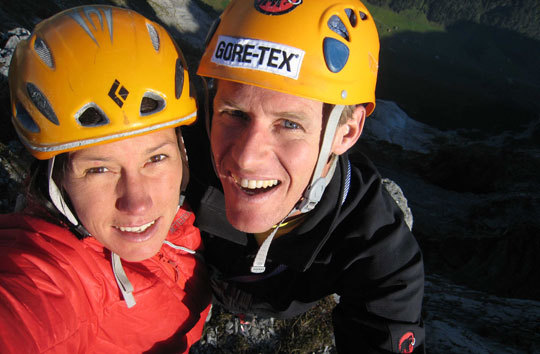
Papert and Siegrist. The two were forever changed by Papert’s fall on the Marmolada. [Photo] Ines Papert